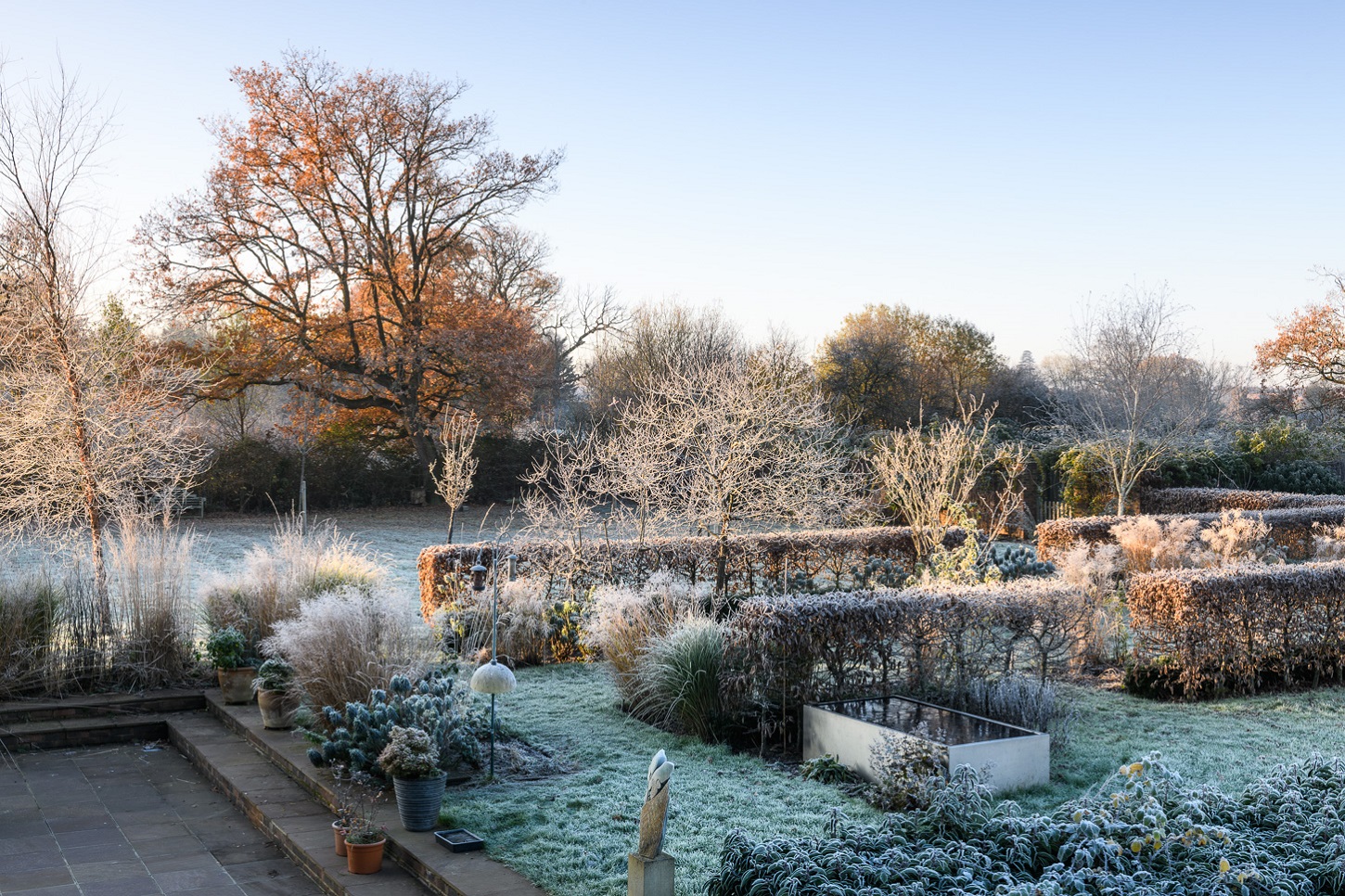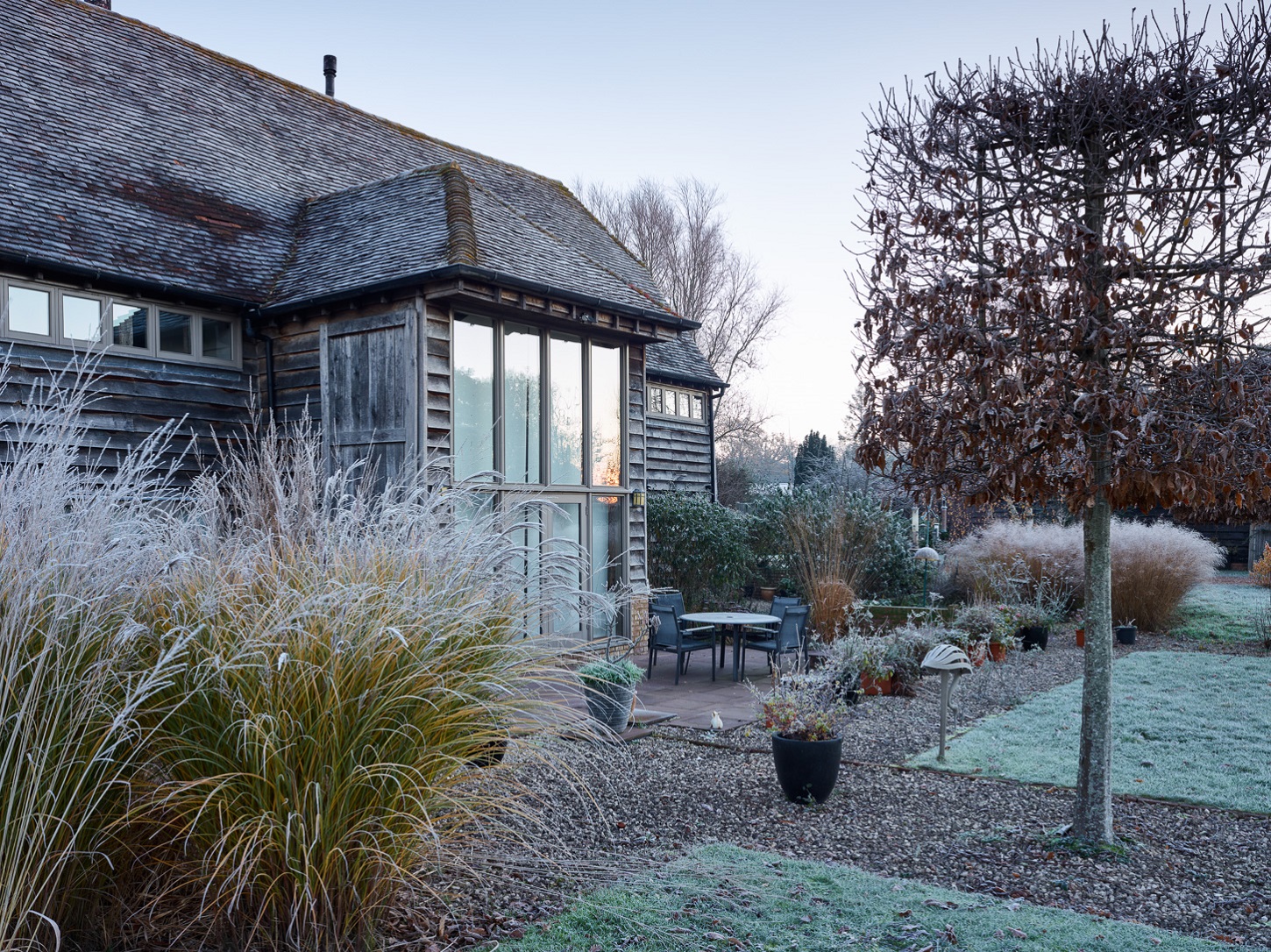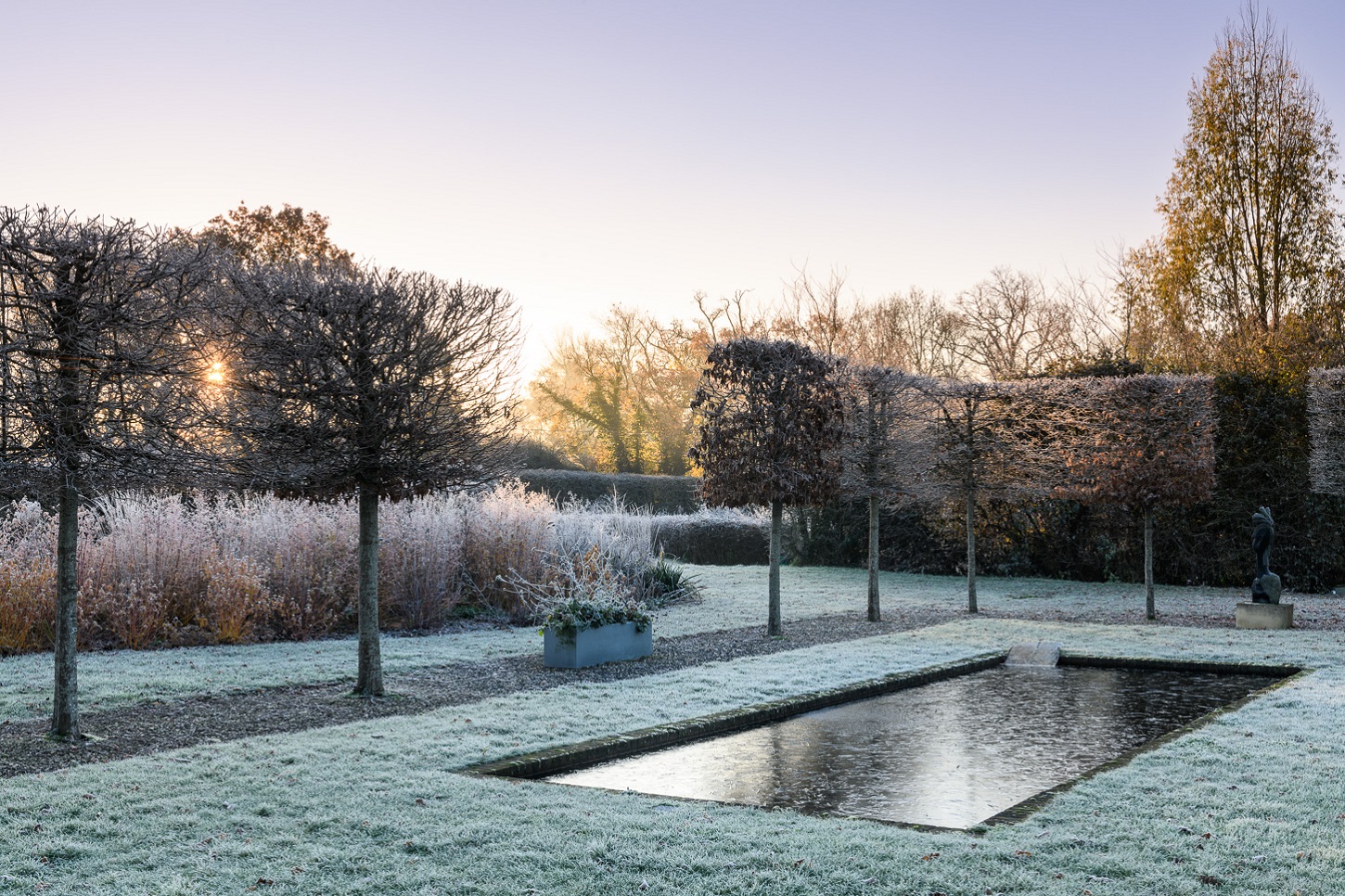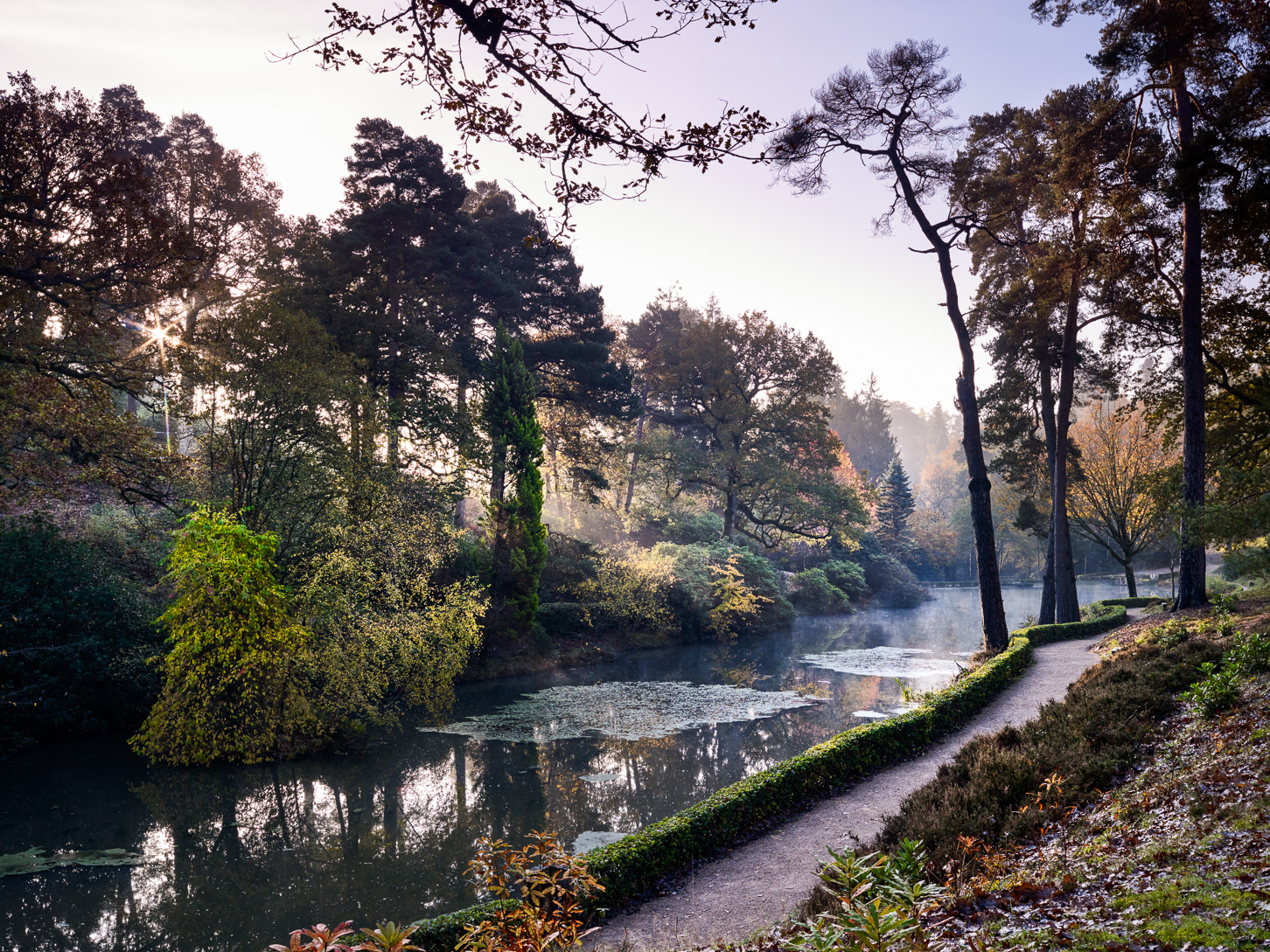The Garden at Standen Barn, Kent: A garden that ties together house and landscape
Formal elements have provided firm foundations in the garden at Standen Barn, near Biddenden, Kent — the home of Prof Roland Rosner and Prof Denise Lievesley. But it is also a garden that is planted for wildlife and surrounded by newly established woodland, reports Tiffany Daneff. Photographs by Jason Ingram.


A garden often has to do a lot of heavy lifting — helping to make a house seem comfortable in the landscape; bringing together disparate elements; hiding or enhancing views; and providing protection from prevailing winds. At Standen Barn in Kent, all the above was required of five acres of flat, open field. The 15th-century black-timbered barn had only stood there since the 1990s and, with its narrow apron of paving, looked out of kilter with its surroundings, so even before there could be any detailed discussion about what kind of garden the owners wanted, there was much that required careful consideration. Roland Rosner and Denise Lievesley realised it was too big a project to do themselves, so they looked for professional help. After some searching, they were recommended Jo Thompson, who first visited the garden in 2010.
Miss Thompson, who has won numerous awards for her garden designs and sits on the RHS Gardens Committee, immediately understood what the owners wanted; namely, to strike a balance between a country garden that reflected the simple, timbered exterior of the barn and something that was modern and spoke to the light and airy contemporary interior. It was also important to create views from the barn, so that, from indoors, the house feels connected to its surroundings.

‘The simplicity of the lines was important, particularly in winter,’ says Miss Thompson, who, 13 years on, remains friends with her clients, offering support and advice. She proposed extending the terrace outside the floor-to-ceiling windows in the dining hall and putting in a rectangular reflecting pool surrounded by a cloister of hornbeam. This was to anchor the house, which had literally been plonked in a field — after being transported here from nearby Penshurst by a previous owner — as well as providing essential height and structure as you came up the short drive.
‘We thought her idea for the terrace was much too big,’ remembers Prof Lievesley. ‘But we were wrong. The barn is three storeys high, so the terrace anchors it and is in proportion. A smaller one would have been out of scale.’
"We were about to clear the brambles in the woods when the nightingale arrived. It stayed with us all summer"
The wider terrace, paved in limestone, extends beyond the barn walls, providing space for table, chairs and loungers, before stepping up to the lawn. The aerial hornbeam hedge serves to screen both the neighbouring house and the mixed native hedge, which was then rather thin and scrappy, but has since filled out with the addition of many more hazels, field maples and hawthorns. Elsewhere, hedges helped to reduce the wind and provide upright structure, dividing up the open field into different areas. Most importantly, Miss Thompson suggested making a walled garden on the boundary to give some height, as well as shelter from the wind, and to support roses, clematis, vines and wisteria.
To link the house and terrace with the walled garden, a series of low, broken hedges delineates a small, semi-formal, rectangular flower garden of jewelled colours (roses, peonies, Cotinus coggygria ‘Royal Purple’), from which a mown path leads through a wildflower meadow to the walled garden. Here, with walls to protect against the wind, planting beds filled with topsoil and compost offset the heavy clay soil. Roses and soft herbaceous perennials billow over the gravel with grasses and euphorbias, giving something to catch the eye in winter, although the central focus is a sculpture. A second, smaller piece is placed on the entrance path. As Miss Thompson felt this one looked too diminutive, she added a timbered pergola with a false perspective to make the far sculpture appear larger. On summer evenings, when the walls trap the scent of the flowers, this is a lovely place to sit.
With most of the bigger picture laid out, the finer details were ready for filling in. A series of rippling water tanks was placed to be seen from the grand piano on the first floor, but of most importance was to garden for wildlife. A lifelong lover of birds, Prof Lievesley wanted a bed outside the kitchen window for buddleias and umbellifers, plus various feeders. An elliptical bed nearby is planted with grasses and cornus for winter stems, providing interest for humans and cover for wildlife.
Exquisite houses, the beauty of Nature, and how to get the most from your life, straight to your inbox.

At one point, the couple tried letting out part of the field for grazing, but were unable to find a suitable smallholder. Instead, nine years ago, they made a new plan — to turn two areas of rough ground into woodland. ‘We approached the Woodland Trust and its staff did a survey listing what they think would have been here originally and what they suggested planting now.’ This was a mix of native trees — field maple, beech, birch, holly and hazel, although not ash, as dieback is a big problem in the area. The trust obtained the trees and the whips went in that autumn, with a local teenager paid to water them through their first year.
‘At first we were shocked by how small the whips were,’ recalls Prof Rosner. Now, nearly all the trees are 15ft–20ft high and thriving. Recently, the professors contacted experts at The Living Forest in Cranbrook for advice on how to look after the woodlands. A pond was proposed for the wet patch beyond the hornbeam cloister, home to great crested newts. The other woodland could be given a clearing, allowing different plant species to develop and provide a greater variety of habitats. ‘They suggested making a path to circle the perimeters, and one through the middle, as well as clearing the brambles, although they said there was no need to thin the young trees as Nature would do this in time.’ Recently, the professors joined Kent Landholders Assisting Wildlife and are thrilled by the number of birds and other species they are able to attract by not over-manicuring the garden.
The woodland areas have made this garden and are providing that sense of permanence that was lacking in 2008. It’s not only in spring, either, when the new leaf emerges on the young beeches and the birches sway in the winds. In winter, the eye is drawn to the shapes made by bare branches against the sky, as well as to the many sculptural pieces the couple have gathered on their travels.
The last word must go to Prof Lievesley: ‘We were about to clear the brambles in the woods when the nightingale arrived. It stayed with us all summer and its song in the middle of the night was exquisite!’

Leonardslee: The gardens that light up West Sussex
Changes are afoot at the famous rhododendron gardens of Leonardslee, which are now being planted for year-round interest. Charles Quest-Ritson

Larch Cottage, Cumbria: An immersive journey amid a wealth of architecture, ornaments and plants to find magic and tranquillity
Charles Quest-Ritson joins the legion of garden enthusiasts who make the pilgrimage to the dramatic plant nurseries at Larch Cottage

The gardens at Great Dixter: How Christopher Lloyd's labour of love lives on
The swashbuckling dahlias still thrill in the late, great Christopher Lloyd's at Great Dixter — in Northiam, East Sussex —
Previously the Editor of GardenLife, Tiffany has also written and ghostwritten several books. She launched The Telegraph gardening section and was editor of IntoGardens magazine. She has chaired talks and in conversations with leading garden designers. She gardens in a wind-swept frost pocket in Northamptonshire and is learning not to mind — too much — about sharing her plot with the resident rabbits and moles.
